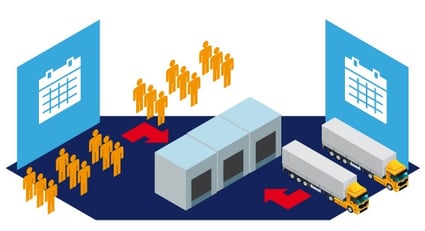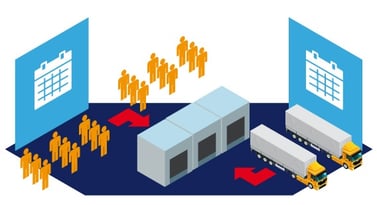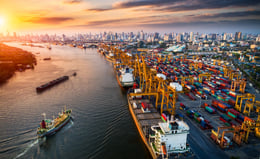The Future of Shipping Is Digital
Brian Hoey - July 24, 2018

 Last month, Abu Dhabi Ports introduced a unique blockchain solution, enabling freight forwarders and their customers to digitally check on the statuses of shipments and transports while facilitating real-time tracking of cargo and documents. Officials expect the result to be a more efficient shipping environment in which reduced paperwork and administrative tasks could potentially slash 20% off of physical shipping costs for freight forwarders who take advantage of the new system. While this might seem revolutionary, it’s actually emblematic of shipping trends that have been evolving for some time. Digitization has been increasing for some time, and the world is finally starting to see the results of this paradigm shift.
Last month, Abu Dhabi Ports introduced a unique blockchain solution, enabling freight forwarders and their customers to digitally check on the statuses of shipments and transports while facilitating real-time tracking of cargo and documents. Officials expect the result to be a more efficient shipping environment in which reduced paperwork and administrative tasks could potentially slash 20% off of physical shipping costs for freight forwarders who take advantage of the new system. While this might seem revolutionary, it’s actually emblematic of shipping trends that have been evolving for some time. Digitization has been increasing for some time, and the world is finally starting to see the results of this paradigm shift.
At this point you may be wondering, “what will shipping’s digital future mean for my business? What challenges will it present and what problems will it help to solve?” If you are, you’re not alone. Hopefully this blog post can give you some insight into the ways that the logistics industry is changing.
Globalization in the Supply Chain
It’s no secret that the supply chain has become increasingly diffuse as a result of globalization. Where once there was a relatively limited number of well-traveled trade routes, new and emerging economies have been changing the paths that goods take from factories to consumers for many years, causing an increase in complexity. While this ongoing process has had a positive impact in a number of sectors, it has also created new challenges for shippers and freight forwarders around the globe. Specifically, it raises the standard for necessary visibility to previously unseen heights, requiring businesses to gain ever more granular insights into their value streams in order to stay competitive and maintain a working understanding of their operations.
As more and more businesses have been discovering, the key to arriving at that level of visibility and transparency is digitization. By trading in pen and paper planning processes for sophisticated digital interfaces that help track, manage, and analyze resources, many shippers and freight forwarders have successfully created open, collaborative digital environments in which mission critical information is effectively kept out of silos. The result is that within any given organization, planners can ascertain the key pieces of data required to stave off bottlenecks, avoid breakdowns, and create more efficient plans and workflows.
Industry 4.0 Integration
One of the most impactful drivers of digitization in shipping in recent years has been a corresponding increase in digitization in the industrial world. Indeed, the rise of Industry 4.0 systems has created an environment in which digital supply chains stand to benefit from increased opportunities for integration. Consider this scenario: you’re a manufacturer of consumer goods trying to find the optimal distribution strategy for your products. Your factory is fully digitized and provides you with real-time views of your production processes and sophisticated analytics insights based on the data collected throughout your supply chain. When it comes time to choose a shipping partner, will you opt for a traditional, non-digitized operation, or will you hold out for a business that has a comparable level of digitization to your own? Most likely you answered that you would choose the more digitally sophisticated shipper—and with good reason. By integrating logistics data from your shipper or freight forwarder’s system into your own value chain, you stand to gain a new level of insight into your supply stream, potentially improving your predictions and reducing disruptions even outside the bounds of your own production stream. This, essentially, is the calculation that many in the shipping trade are beginning to make, i.e. that digitization can be a means of providing value not just within one’s own operations, but for one’s customers.
Looking to the Future
Of course, all of the compelling reasons to go digital have not caused universal adoption. In fact, while entities like Abu Dhabi Ports push the technological envelope within their respective spheres of influence, the overall adoption of digitized processes across the logistics sector remains piecemeal and incomplete. Even otherwise fully digitized businesses run some risk of finding areas where they cannot track their cargo in real time or easily access mission critical information. Though smart ports, real time fleet tracking, and heat and light sensors for shipping containers will continue to proliferate, there will also continue to be a competitive advantage to be gained by offering digital logistics services.
More than that, early adopters will be well equipped to benefit from new technologies as they emerge. Blockchain, for instance, is already gaining traction in the supply chain, and digital shippers are going to be in a position to leverage this emerging technology into increased end-to-end (E2E) visibility, and therefore more value for their customers. By the same token, digital responses to disruptions will get faster and more efficient as resource usage and availability becomes increasingly transparent. If Abu Dhabi is creating the port of the future with its new technology, it’s time to envision a digital shipper of the future to match that vision.
LATEST POSTS
- Understand Why Production Planning Needs Specialized Solutions
- Understand Circular Economy in The Manufacturing Industry
- How Can Industry 4.0 IT Integration Be Achieved Smoothly?
- The Significance of Order Sequencing in Discrete Manufacturing
- How to improve your Supply Chain Management: The Power of Control Towers



